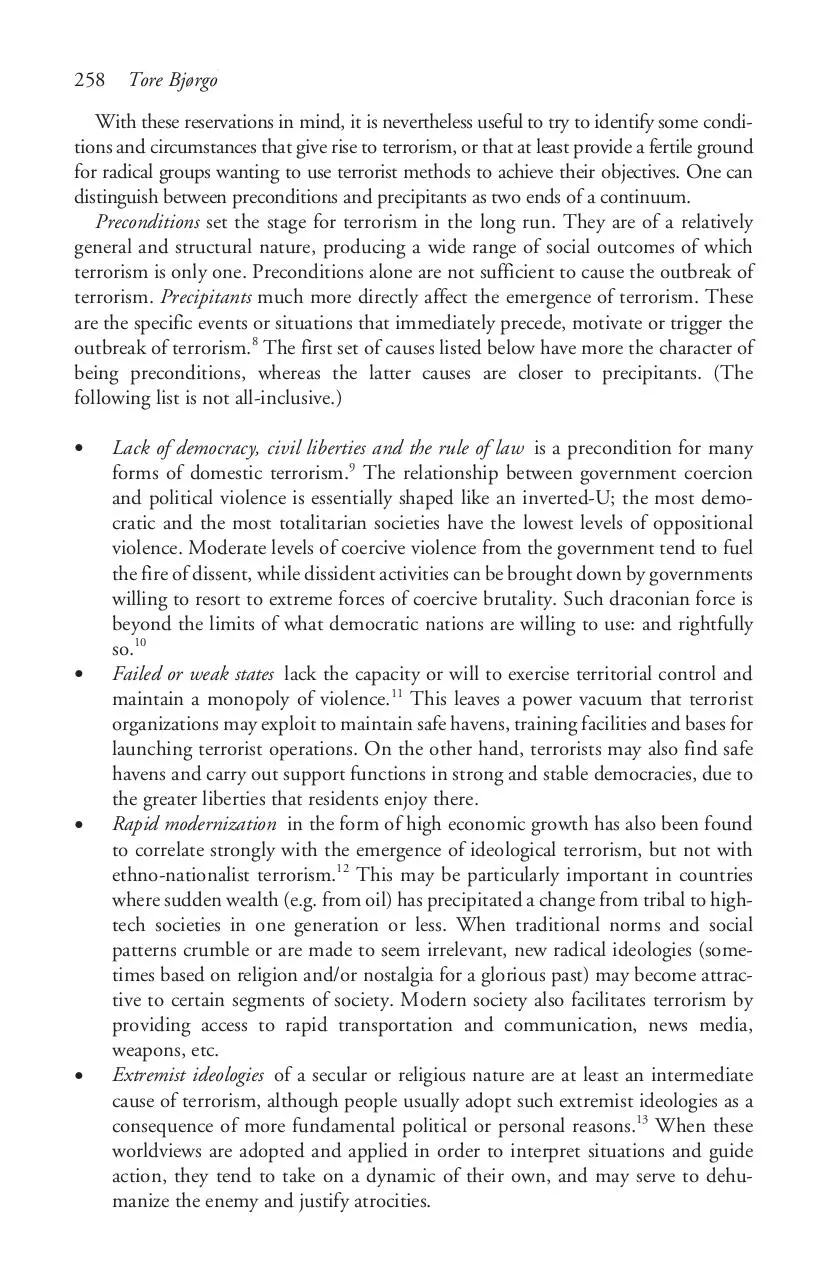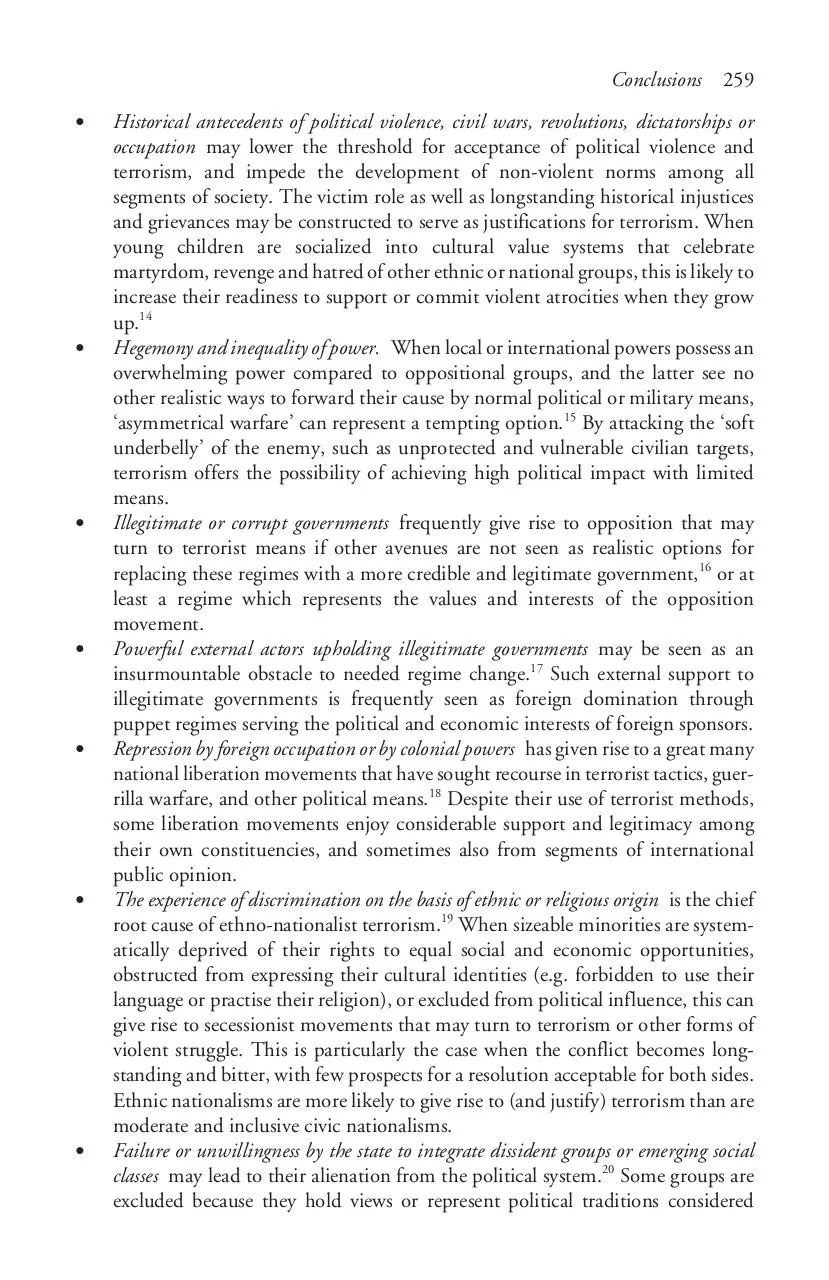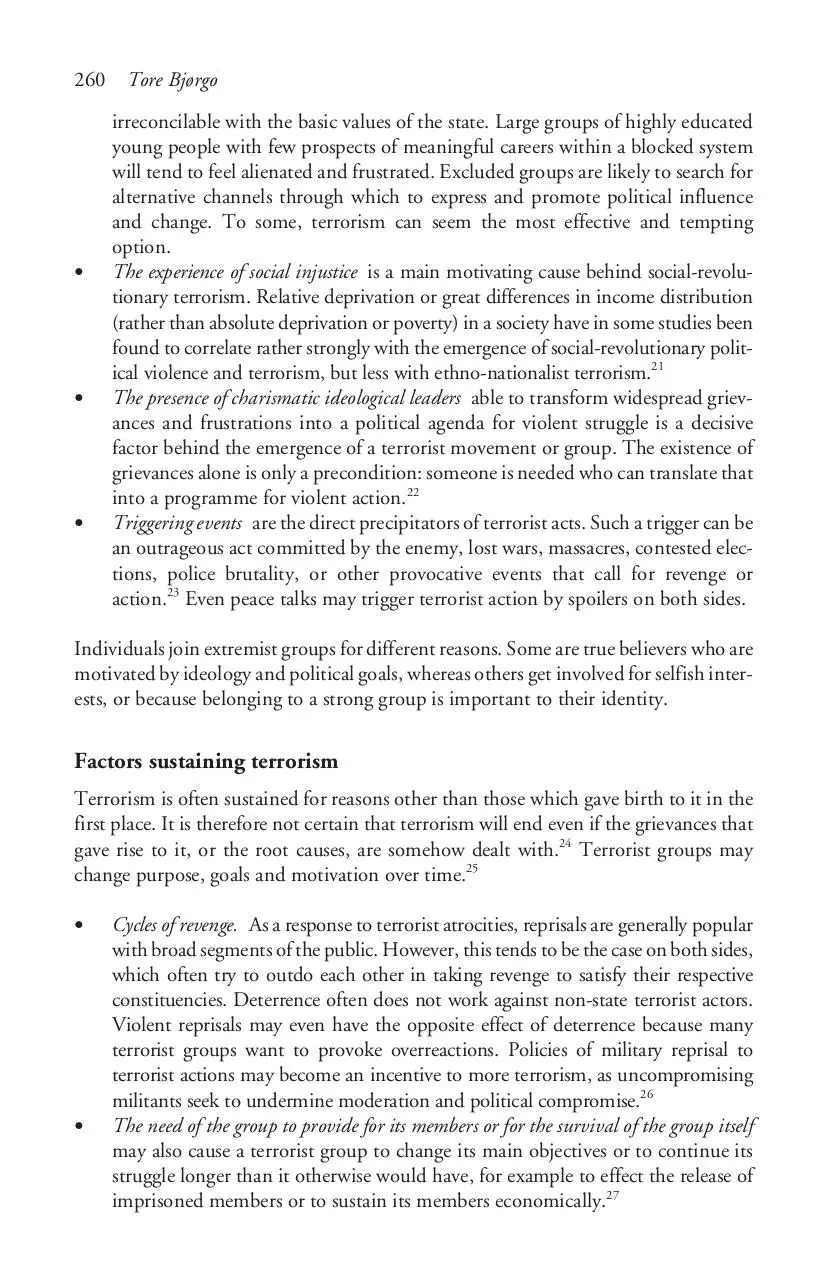Bjorgo Conclusions (PDF)
File information
Title: Root Causes of Terrorism: Myths, Reality and Ways Forward
Author: Tore Bjorgo (edt)
This PDF 1.6 document has been generated by PScript5.dll Version 5.2 / Acrobat Distiller 5.0.5 (Windows), and has been sent on pdf-archive.com on 27/03/2016 at 22:47, from IP address 109.130.x.x.
The current document download page has been viewed 1584 times.
File size: 69.63 KB (7 pages).
Privacy: public file





File preview
20 Conclusions
Tore Bjørgo1
Addressing factors that cause a recurring problem is usually preferable to dealing with
symptoms and consequences. If an area suffers from mosquitoes, draining the swamps
where they breed is usually a more effective strategy than trying to kill all the individual insects.2 This principle applies to terrorism as well as to many other problem
areas. The approach requires, however, that we can identify causes and mechanisms
that are of such a nature that they are available for intervention and possible to change.
For this approach to be effective, it requires that the causes identified for intervention
should be specific and have a direct causal relationship to the problem. This is by no
means easy to achieve with such a complex and multifarious phenomenon as
terrorism. Nevertheless, it has been a main objective of this book to explore these
possibilities.
Given the diverse views and backgrounds of the contributors to this book, it would
not be realistic to achieve a consensus on what constitutes the root causes of terrorism.
Still, to a surprising degree, the preceding chapters point in the same direction on
many critical issues.
Debunking myths about root causes of terrorism
A main accomplishment of this book was to invalidate several widely held ideas about
what causes terrorism. There is broad agreement that:
•
There is only a weak and indirect relationship between poverty and terrorism.3 At the
individual level, terrorists are generally not drawn from the poorest segments of
their societies. Typically, they are at average or above-average levels in terms of
education and socio-economic background. Poor people are more likely to take
part in other or simpler forms of political violence than terrorist campaigns, such
as riots and civil wars (which may certainly involve acts of terrorist violence). The
level of terrorism is not particularly high in the poorest countries of the world.
Terrorism is more commonly associated with countries with a medium level of
economic development, often emerging in societies characterized by rapid
modernization and transition. On the other hand, poverty has frequently been
used as justification for violence by social-revolutionary terrorists, who may claim
Conclusions
•
•
•
257
to represent the poor and marginalized without being poor themselves. Some
data also suggest that poverty may be a factor of some significance for the recruitment of certain types of terrorist actors (or possibly, into particular roles within a
terrorist group).4 Although not a general root cause of terrorism, poverty is a
social evil that should be fought for its own reasons.
State sponsorship is not a root cause of terrorism.5 Used as an instrument in their
foreign policies, some states have capitalized on pre-existing terrorist groups
rather than creating them. Terrorist groups have often been the initiators of these
relationships, at times courting several potential state sponsors in order to
enhance their own independence. State sponsorship is clearly an enabling factor
of terrorism, giving terrorist groups a far greater capacity and lethality than they
would have had on their own. States have exercised varying degrees of control
over the groups they have sponsored, ranging from using terrorists as ‘guns for
hire’ to having virtually no influence at all over their operations. Tight state
control is rare. Also Western democratic governments have occasionally
supported terrorist organizations as a foreign policy means.
Suicide terrorism is not caused by religion (or more specifically Islam) as such.6 Many
suicide terrorists around the world are secular, or belong to other religions than
Islam. Suicide terrorists are motivated mainly by political goals, usually to end
foreign occupation or domestic domination by a different ethnic group. Their
‘martyrdom’ is, however, frequently legitimized and glorified with reference to
religious ideas and values.
Terrorists are not insane or irrational actors.7 Symptoms of psychopathology are
not common among terrorists. Neither do suicide terrorists, as individuals,
possess the typical risk factors of suicide. There is no common personality profile
that characterizes most terrorists, who appear to be relatively normal individuals.
Terrorists may follow their own rationalities based on extremist ideologies or
particular terrorist logics, but they are not irrational.
What causes terrorism?
The notion of terrorism is applied to a great diversity of groups with different origins
and goals. Terrorism occurs in wealthy countries as well as in poor countries, in
democracies as well as in authoritarian states. Thus, there exists no single root cause of
terrorism, or even a common set of causes. There are, however, a number of preconditions and precipitants for the emergence of various forms of terrorism.
One limitation of the ‘root cause’ approach is the underlying idea that terrorists are
just passive pawns of the social, economic and psychological forces around them;
doing what these ‘causes’ compel them to do. It is more useful to see terrorists as
rational and intentional actors who develop deliberate strategies to achieve political
objectives. They make their choices between different options and tactics, on the basis
of the limitations and possibilities of the situation. Terrorism is better understood as
emerging from a process of interaction between different parties, than as a mechanical
cause-and-effect relationship.
258 Tore Bjørgo
1
With these reservations in mind, it is nevertheless useful to try to identify some conditions and circumstances that give rise to terrorism, or that at least provide a fertile ground
for radical groups wanting to use terrorist methods to achieve their objectives. One can
distinguish between preconditions and precipitants as two ends of a continuum.
Preconditions set the stage for terrorism in the long run. They are of a relatively
general and structural nature, producing a wide range of social outcomes of which
terrorism is only one. Preconditions alone are not sufficient to cause the outbreak of
terrorism. Precipitants much more directly affect the emergence of terrorism. These
are the specific events or situations that immediately precede, motivate or trigger the
outbreak of terrorism.8 The first set of causes listed below have more the character of
being preconditions, whereas the latter causes are closer to precipitants. (The
following list is not all-inclusive.)
•
•
•
•
Lack of democracy, civil liberties and the rule of law is a precondition for many
forms of domestic terrorism.9 The relationship between government coercion
and political violence is essentially shaped like an inverted-U; the most democratic and the most totalitarian societies have the lowest levels of oppositional
violence. Moderate levels of coercive violence from the government tend to fuel
the fire of dissent, while dissident activities can be brought down by governments
willing to resort to extreme forces of coercive brutality. Such draconian force is
beyond the limits of what democratic nations are willing to use: and rightfully
so.10
Failed or weak states lack the capacity or will to exercise territorial control and
maintain a monopoly of violence.11 This leaves a power vacuum that terrorist
organizations may exploit to maintain safe havens, training facilities and bases for
launching terrorist operations. On the other hand, terrorists may also find safe
havens and carry out support functions in strong and stable democracies, due to
the greater liberties that residents enjoy there.
Rapid modernization in the form of high economic growth has also been found
to correlate strongly with the emergence of ideological terrorism, but not with
ethno-nationalist terrorism.12 This may be particularly important in countries
where sudden wealth (e.g. from oil) has precipitated a change from tribal to hightech societies in one generation or less. When traditional norms and social
patterns crumble or are made to seem irrelevant, new radical ideologies (sometimes based on religion and/or nostalgia for a glorious past) may become attractive to certain segments of society. Modern society also facilitates terrorism by
providing access to rapid transportation and communication, news media,
weapons, etc.
Extremist ideologies of a secular or religious nature are at least an intermediate
cause of terrorism, although people usually adopt such extremist ideologies as a
consequence of more fundamental political or personal reasons.13 When these
worldviews are adopted and applied in order to interpret situations and guide
action, they tend to take on a dynamic of their own, and may serve to dehumanize the enemy and justify atrocities.
Conclusions
•
•
•
•
•
•
•
259
Historical antecedents of political violence, civil wars, revolutions, dictatorships or
occupation may lower the threshold for acceptance of political violence and
terrorism, and impede the development of non-violent norms among all
segments of society. The victim role as well as longstanding historical injustices
and grievances may be constructed to serve as justifications for terrorism. When
young children are socialized into cultural value systems that celebrate
martyrdom, revenge and hatred of other ethnic or national groups, this is likely to
increase their readiness to support or commit violent atrocities when they grow
up.14
Hegemony and inequality of power. When local or international powers possess an
overwhelming power compared to oppositional groups, and the latter see no
other realistic ways to forward their cause by normal political or military means,
‘asymmetrical warfare’ can represent a tempting option.15 By attacking the ‘soft
underbelly’ of the enemy, such as unprotected and vulnerable civilian targets,
terrorism offers the possibility of achieving high political impact with limited
means.
Illegitimate or corrupt governments frequently give rise to opposition that may
turn to terrorist means if other avenues are not seen as realistic options for
replacing these regimes with a more credible and legitimate government,16 or at
least a regime which represents the values and interests of the opposition
movement.
Powerful external actors upholding illegitimate governments may be seen as an
insurmountable obstacle to needed regime change.17 Such external support to
illegitimate governments is frequently seen as foreign domination through
puppet regimes serving the political and economic interests of foreign sponsors.
Repression by foreign occupation or by colonial powers has given rise to a great many
national liberation movements that have sought recourse in terrorist tactics, guerrilla warfare, and other political means.18 Despite their use of terrorist methods,
some liberation movements enjoy considerable support and legitimacy among
their own constituencies, and sometimes also from segments of international
public opinion.
The experience of discrimination on the basis of ethnic or religious origin is the chief
root cause of ethno-nationalist terrorism.19 When sizeable minorities are systematically deprived of their rights to equal social and economic opportunities,
obstructed from expressing their cultural identities (e.g. forbidden to use their
language or practise their religion), or excluded from political influence, this can
give rise to secessionist movements that may turn to terrorism or other forms of
violent struggle. This is particularly the case when the conflict becomes longstanding and bitter, with few prospects for a resolution acceptable for both sides.
Ethnic nationalisms are more likely to give rise to (and justify) terrorism than are
moderate and inclusive civic nationalisms.
Failure or unwillingness by the state to integrate dissident groups or emerging social
classes may lead to their alienation from the political system.20 Some groups are
excluded because they hold views or represent political traditions considered
260 Tore Bjørgo
•
•
•
1
irreconcilable with the basic values of the state. Large groups of highly educated
young people with few prospects of meaningful careers within a blocked system
will tend to feel alienated and frustrated. Excluded groups are likely to search for
alternative channels through which to express and promote political influence
and change. To some, terrorism can seem the most effective and tempting
option.
The experience of social injustice is a main motivating cause behind social-revolutionary terrorism. Relative deprivation or great differences in income distribution
(rather than absolute deprivation or poverty) in a society have in some studies been
found to correlate rather strongly with the emergence of social-revolutionary political violence and terrorism, but less with ethno-nationalist terrorism.21
The presence of charismatic ideological leaders able to transform widespread grievances and frustrations into a political agenda for violent struggle is a decisive
factor behind the emergence of a terrorist movement or group. The existence of
grievances alone is only a precondition: someone is needed who can translate that
into a programme for violent action.22
Triggering events are the direct precipitators of terrorist acts. Such a trigger can be
an outrageous act committed by the enemy, lost wars, massacres, contested elections, police brutality, or other provocative events that call for revenge or
action.23 Even peace talks may trigger terrorist action by spoilers on both sides.
Individuals join extremist groups for different reasons. Some are true believers who are
motivated by ideology and political goals, whereas others get involved for selfish interests, or because belonging to a strong group is important to their identity.
Factors sustaining terrorism
Terrorism is often sustained for reasons other than those which gave birth to it in the
first place. It is therefore not certain that terrorism will end even if the grievances that
gave rise to it, or the root causes, are somehow dealt with.24 Terrorist groups may
change purpose, goals and motivation over time.25
•
•
Cycles of revenge. As a response to terrorist atrocities, reprisals are generally popular
with broad segments of the public. However, this tends to be the case on both sides,
which often try to outdo each other in taking revenge to satisfy their respective
constituencies. Deterrence often does not work against non-state terrorist actors.
Violent reprisals may even have the opposite effect of deterrence because many
terrorist groups want to provoke overreactions. Policies of military reprisal to
terrorist actions may become an incentive to more terrorism, as uncompromising
militants seek to undermine moderation and political compromise.26
The need of the group to provide for its members or for the survival of the group itself
may also cause a terrorist group to change its main objectives or to continue its
struggle longer than it otherwise would have, for example to effect the release of
imprisoned members or to sustain its members economically.27
Conclusions
•
•
261
Profitable criminal activities to finance their political and terrorist campaigns
may eventually give terrorist groups vested interests in continuing their actions
long after they realize that their political cause is lost.28 Alternatively, some
continue even if many of their political demands have been met.
No exit. With ‘blood on their hands’ and having burnt all bridges back to mainstream society, some terrorist groups and individuals continue their underground
struggle because the only alternative is long-term imprisonment or death.29
Serious consideration should be given to ways of bringing the insurgent movement back into the political process, or at least offering individual terrorists a way
out (such as reduced sentences or amnesty) if they break with their terrorist past
and cooperate with the authorities. Such policies have in fact helped to bring
terrorism to an end in several countries.
Final remarks
Several of the causes of terrorism described above are of such a nature that they might
be addressed and influenced in a direction that would make them less likely to
produce terrorism; or more precisely, to induce persons and groups to choose other
modes of action than terrorist violence. However, there are also a number of root
causes (or preconditions) of terrorism that cannot be ‘removed’ because they are
beyond our capacity to change.
Many terrorist insurgencies will not come to an end before their root causes are
addressed and fundamental grievances and rights are provided for. However,
terrorism will not necessarily disappear even if the root causes are dealt with, because
terrorism is often sustained for reasons other than those which produced it. That is
why we should pay particular attention to the factors that sustain terrorist campaigns.
Moreover, we are often not in a position to address terrorist grievances as such until
the terrorist campaign has developed.30
In counter-terrorism efforts, it is crucial to uphold democratic principles and maintain moral and ethical standards while fighting terrorism. Increased repression and coercion are likely to feed terrorism, rather than reduce it.31 Extremist ideologies that
promote hatred and terrorism should be confronted on ideological grounds by investing
more effort into challenging them politically, and not only by the use of coercive force.
Many of the causes of terrorism are also the causes of rebellious guerrilla warfare, riots
and other forms of political violence. What distinguishes terrorist violence from other
forms of violence used in waging political and armed conflict is its criminal and normless
character, with deliberate attacks on civilians, indiscriminate bombings, the taking of
hostages: tactics that would qualify as war crimes in conventional armed conflicts. Thus,
acts of terrorism can be seen as the peace-time equivalents of war crimes.32
We need insights into the conditions and processes leading up to terrorist atrocities
if we are to identify possible avenues of prevention, early intervention, or ways of
breaking the vicious circle of terrorist revenge and counter-revenge. Such understanding does not mean accepting or justifying the use of terrorist methods. The political goals for which terrorists wage conflict may be legitimate in some cases and unjust
262 Tore Bjørgo
1
in others; but deliberate and indiscriminate targeting of civilians as a tactic to achieve
these goals is never acceptable.
Target hardening and suppressing terrorism by law enforcement or military means
are short-term but often indispensable measures to respond to specific terrorist threats.
At its best, competent police work and intelligence have prevented many planned
terrorist actions from being carried through.33 Still, redressing the grievances that give
rise to terrorism offers the best prospects for reducing terrorist violence in the long run.
However, given the complexity of the phenomenon and the difficulties involved in
changing deep-seated structures and patterns of domination, the run may sometimes
become very long. Committed terrorists are not likely to change their views or mode of
action due to political reforms, but their social and political support base is far more
likely to dry up.34 To reduce the conditions that provide recruitment and popular
support for international Jihadist terrorism, we will probably have to think in terms of
decades rather than months or years, involving a wide range of social and political
changes. There are no quick fixes to this problem. Other terrorist campaigns,
concerning conflicts over a share of power or independence rather than totalitarian
demands, are often more amenable for political initiatives and compromise.35 To avoid
rewarding terrorism, it is preferable to direct offers and negotiations towards nonterrorist parts of the insurgency. This is not always possible, though. Sometimes groups
involved in terrorism will have to be parties to a political settlement if such a solution
shall be achieved.36 When terrorist demands are extreme and totalitarian, a wiser political response would often be to isolate the extremists and talk with more moderate
factions, and avoid branding as terrorist everyone promoting the political case.
Trying to deal with the causes of terrorism in its general form is less rewarding than
addressing the causes of specific forms of terrorism or specific terrorist campaigns. If
such insights shall be of practical use, the challenge is twofold. At the preventive level,
the challenge is to identify at an early stage grievances, factors and developments that
make a certain conflict escalate in such a direction that some elements are likely to
turn to terrorist methods, and then try to influence these causes. If a terrorist
campaign has already developed, the challenge is to identify factors which sustain the
ongoing campaign, and remove them or alleviate their negative consequences.
The notion of ‘addressing the root causes of terrorism’ may become a dead end if by
‘root’ we mean the distant and general issues such as poverty, globalization and
modernization that are far removed from the actual acts of terrorism and extremely
difficult to change. The approach is far more promising if we focus on the more
immediate causes and circumstances that motivate and facilitate specific campaigns
and acts of terrorism.37 Future research and efforts should move in this direction.
Notes
1
2
The findings described in this chapter are conclusions drawn by the editor/chairman of the Oslo
Expert Conference on Root Causes of Terrorism on the basis of presentations and discussions. Thus each
individual expert on the panel may not necessarily agree with every single conclusion or statement.
Addressing causes of problems rather than symptoms and consequences, being proactive rather than
Download Bjorgo - Conclusions
Bjorgo - Conclusions.pdf (PDF, 69.63 KB)
Download PDF
Share this file on social networks
Link to this page
Permanent link
Use the permanent link to the download page to share your document on Facebook, Twitter, LinkedIn, or directly with a contact by e-Mail, Messenger, Whatsapp, Line..
Short link
Use the short link to share your document on Twitter or by text message (SMS)
HTML Code
Copy the following HTML code to share your document on a Website or Blog
QR Code to this page

This file has been shared publicly by a user of PDF Archive.
Document ID: 0000353725.